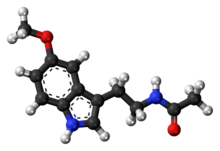Melatonin
 |
|
 |
|
| Clinical data | |
|---|---|
| Pronunciation | |
| AHFS/Drugs.com | Consumer Drug Information |
| Routes of administration |
Oral, sublingual, transdermal |
| ATC code | |
| Legal status | |
| Legal status | |
| Pharmacokinetic data | |
| Bioavailability | 30–50% |
| Metabolism | Hepatic via CYP1A2 mediated 6-hydroxylation |
| Biological half-life | 35–50 minutes |
| Excretion | Renal |
| Identifiers | |
|
|
| CAS Number | |
| PubChem CID | |
| IUPHAR/BPS | |
| DrugBank | |
| ChemSpider | |
| UNII | |
| KEGG | |
| ChEBI | |
| ChEMBL | |
| ECHA InfoCard | 100.000.725 |
| Chemical and physical data | |
| Formula | C13H16N2O2 |
| Molar mass | 232.28 g·mol−1 |
| 3D model (Jmol) | |
|
|
|
|
Melatonin, also known as N-acetyl-5-methoxy tryptamine, is a hormone that is produced by the pineal gland in animals and regulates sleep and wakefulness. Melatonin is also produced in plants where it functions as a first line of defense against oxidative stress.
In animals, melatonin is involved in the entrainment (synchronization) of the circadian rhythms including sleep-wake timing, blood pressure regulation, seasonal reproduction, and many others. Many of its biological effects in animals are produced through activation of melatonin receptors, while others are due to its role as an antioxidant, with a particular role in the protection of nuclear and .
As a medicine, it is used for the treatment of insomnia; however, scientific evidence is insufficient to demonstrate a benefit in this area. Melatonin is sold over the counter in the United States and Canada. In other countries, it may require a prescription or it may be unavailable.
Melatonin has shown promise in treating sleep-wake cycle disorders in children with underlying neurodevelopment difficulties. As add-on to antihypertensive therapy, prolonged-release melatonin has improved blood pressure control in people with nocturnal hypertension.
People with circadian rhythm sleep disorders may use oral melatonin to help entrain (biologically synchronize in the correct phase) to the environmental light-dark cycle. Melatonin reduces sleep onset latency to a greater extent in people with delayed sleep phase disorder than in people with insomnia.
Melatonin has been studied for insomnia in the elderly. Prolonged-release melatonin has shown good results in treating insomnia in older adults. Short-term treatment (up to three months) of prolonged-release melatonin was found to be effective and safe in improving sleep latency, sleep quality, and daytime alertness.
...
Wikipedia
